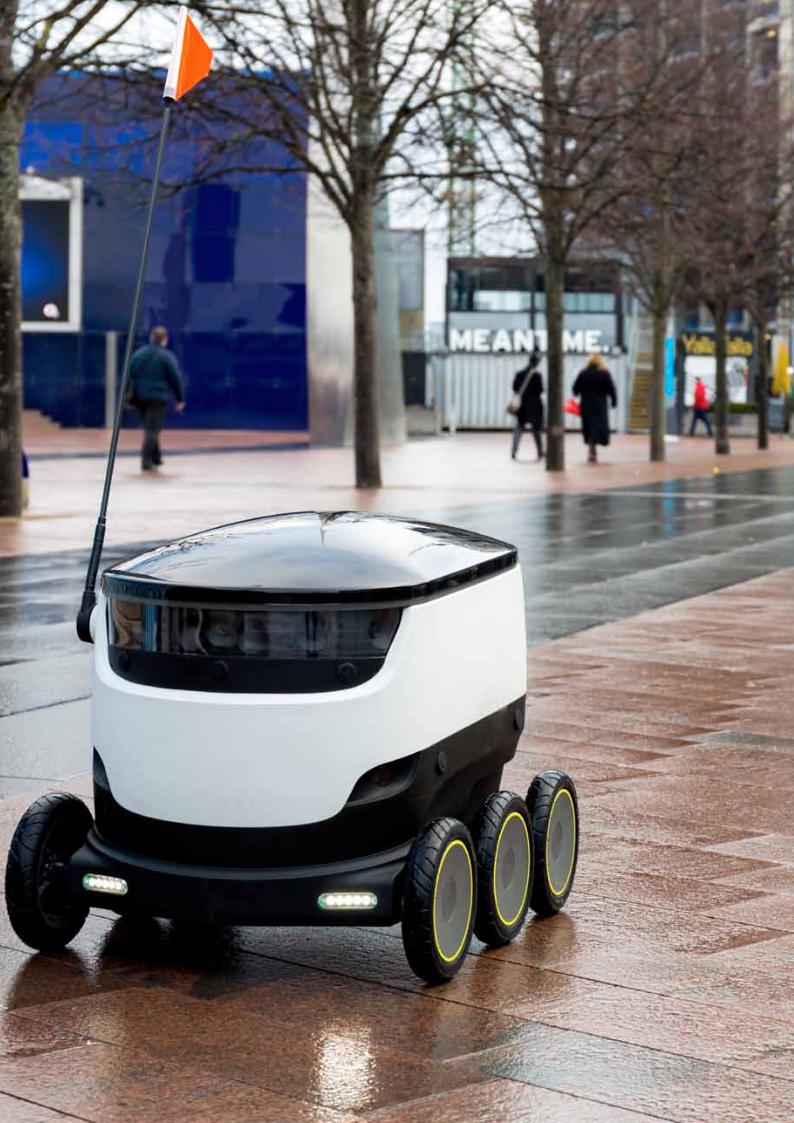
Report - How Robots Change the World_watermark
.pdf
vk.com/id446425943
How Robots Change the World
UNITED KINGDOM
 Low vulnerability
Low vulnerability
 Lower-medium vulnerability
Lower-medium vulnerability
 Upper-medium vulnerability
Upper-medium vulnerability
 High vulnerability
High vulnerability
The UK’s most  vulnerable regions to
vulnerable regions to 
robotization can be found in its more rural areas. These  sparsely populated regions
sparsely populated regions
may contain towns with concentrated manufacturing industries. Cumbria tops our UK Index.
The West Midlands’ manufacturing processes are already among the most automated in the UK, and the region is nearly as robot-dense as international market leaders. However, it is also characterised by low levels of productivity, and with a high dependence on manufacturing employment, which could still
imply a challenging future.
East Yorkshire and Northern
Lincolnshire, Shropshire and
Sta•ordshire, Cumbria, and West Wales and the Valleys exhibit the highest vulnerability scores in the UK. These regions are relatively dependent on manufacturing for employment, and have a relatively high incidence of low-skilled workers.
Robotization will exacerbate the north-south divide. Inner London is perhaps the least vulnerable part of the country to the rise of robots, and the South East region is similarly well-placed for the next phase of industrial automation.
Manufacturing operations in these regions tend to be more advanced and more automated than in other parts of the country, reflecting the higher cost
of labour here.
|
Region: |
Index Score: |
|
Region: |
Index Score: |
||
Most |
Cumbria |
|
0.59 |
Least |
Inner London (East) |
0.15 |
|
East Yorkshire & |
|
|
Inner London (West) |
0.17 |
|||
vulnerable |
North Lincolnshire |
0.59 |
vulnerable |
Outer London |
|
0.20 |
|
regions |
Shropshire & |
|
|
regions |
(West & NW) |
|
|
Sta•ordshire |
|
0.58 |
Berks, Bucks & |
|
|
||
|
|
|
|
|
|||
|
West Wales & |
|
|
|
Oxfordshire |
|
0.25 |
|
the Valleys |
|
0.56 |
|
Surrey, East & |
|
|
|
Lincolnshire |
|
0.54 |
|
West Sussex |
|
0.28 |
|
|
|
|
|
|
|
|
29

vk.com/id446425943
How Robots Change the World
FRANCE
 Low vulnerability
Low vulnerability
 Lower-medium vulnerability
Lower-medium vulnerability
 Upper-medium vulnerability
Upper-medium vulnerability
 High vulnerability
High vulnerability
France’s most southerly regions, plus Rhône-Alpes, are collectively the ‘runners-up’ behind Paris in terms of their low vulnerability on our Index. These regions are home to advanced
high-tech manufacturing companies, notably in leading cities such as Toulouse (home to Airbus, among others) and Grenoble, and thus benefit from a future-ready,
highly skilled workforce.
Most |
Region: |
Index Score: |
|
Franche-Comté |
0.61 |
||
vulnerable |
|||
Basse-Normandie |
0.51 |
||
regions |
Picardie |
0.51 |
|
|
|||
|
Limousin |
0.51 |
|
|
Auvergne |
0.49 |
Least vulnerable
regions
The Île-de-France, centred on Paris, is France’s least-vulnerable region. It is least dependent on manufacturing jobs, and what manufacturing activity it does have is (a) highly productive and (b) the most robot-intensive in the country, alongside the Midi-Pyrenees. This means it
has already undertaken significant levels of automation
We find that the most vulnerable region to robotization is Franche-Comté. France’s most manufacturing-intensive region is nevertheless relatively rural and sparsely populated. Its relatively low rate of robotization means there could be high levels of automation coming.
Region: |
Index Score: |
|
Île de France |
|
0.03 |
Provence-Alpes-Côte |
|
|
d'Azur |
|
0.26 |
Languedoc-Roussillon |
0.30 |
|
Aquitaine |
|
0.35 |
Midi-Pyrénées |
|
0.36 |
30

vk.com/id446425943
How Robots Change the World
JAPAN
|
Hokkaido, |
|
Japan’s northernmost |
|
island—famous for brewing beer |
Low vulnerability |
and as a skiing destination and |
Lower-medium vulnerability |
gateway to the Hokkaido |
mountains—is one of the least |
|
Upper-medium vulnerability |
manufacturing-intensive parts of the |
High vulnerability |
country. After Tokyo, it is the |
second-least vulnerable region on |
|
|
our Index. |
Some of Japan’s most |
|
mountainous prefectures |
|
feature among the most |
|
vulnerable to job losses. Although |
|
sparsely populated, these large |
|
regions are punctuated with |
|
traditional manufacturing enclaves, |
|
which may prove highly vulnerable to |
|
change. The regions of Kochi, Nara, |
|
and rural Tottori are, in this sense, |
|
among the most vulnerable to |
|
the trends of automation. |
|
 Japan’s
Japan’s
largest and most economically important prefecture, Tokyo, is the country’s least-exposed region to robots displacing manufacturing jobs, according to our Index. Companies here have already established advanced levels of robot intensity, and the region’s diverse economy means workers are less dependent on the manufacturing sector for employment. A similar pattern is true of the regions surrounding other important cities
such as Osaka, Yokohama, and
Kawasaki.
Most |
Region: |
Index Score: |
Least |
Region: |
Index Score: |
|
Tottori |
0.54 |
Tokyo |
0.09 |
|||
vulnerable |
vulnerable |
|||||
Kochi |
0.51 |
Hokkaido |
0.20 |
|||
regions |
Nara |
0.49 |
regions |
Osaka |
0.25 |
|
|
|
|||||
|
Shiga |
0.49 |
|
Fukuoka |
0.28 |
|
|
Saga |
0.48 |
|
Miyagi |
0.28 |
31

vk.com/id446425943
How Robots Change the World
SOUTH KOREA
 Low vulnerability
Low vulnerability  Lower-medium vulnerability
Lower-medium vulnerability
 Upper-medium vulnerability
Upper-medium vulnerability  High vulnerability
High vulnerability 
Incheon and Daegu are the most exposed regions. These major
manufacturing hubs have relatively low levels of manufacturing  productivity, so are
productivity, so are 
ripe for change.
Workers in South Korea’s largest city, Seoul, are the country’s least vulnerable to the growth of manufacturing robots. The regional economy is diverse, meaning it has a low dependence on the manufacturing sector for work, and the labour force is highly productive.
 Korea’s second city, Busan, and its neighbour, Ulsan, appear vulnerable to robots on our Index. Ulsan is home to major car plants,
Korea’s second city, Busan, and its neighbour, Ulsan, appear vulnerable to robots on our Index. Ulsan is home to major car plants,
shipbuilding facilities, and oil refineries. It has very high levels of manufacturing productivity, but its relatively high robot vulnerability score is driven by a remarkable dependence on manufacturing employment.
Most |
Region: |
Index Score: |
Least |
Region: |
Index Score: |
|
Daegu |
0.38 |
Seoul |
0.11 |
|||
vulnerable |
vulnerable |
|||||
Incheon |
0.35 |
Jeollanam-do |
0.13 |
|||
regions |
Ulsan |
0.33 |
regions |
Gangwon |
0.19 |
|
|
|
|||||
|
Gyeongnam |
0.32 |
|
Chungcheongnam-do 0.21 |
||
|
Busan |
0.29 |
|
Gyeongbuk |
0.23 |
|
32

vk.com/id446425943
How Robots Change the World
AUSTRALIA
 Low vulnerability
Low vulnerability
 Lower-medium vulnerability
Lower-medium vulnerability
 Upper-medium vulnerability
Upper-medium vulnerability
 High vulnerability
High vulnerability
South Australia
is the most vulnerable part of the country to future robot rollout, according to our Index. The state is Australia’s most manufacturing intensive but has the slowest-growing economy and low levels of manufacturing
productivity.
Australia’s most populous state, New South Wales, looks rather less vulnerable than either Victoria or South Australia. In this state, the labour market has become
less dependent on manufacturing
jobs in recent years, while
manufacturing productivity has
improved. So the impact of
further robot densification will likely be muted.
 Victoria is less vulnerable
Victoria is less vulnerable
to robots than South


 Australia, and also faster
Australia, and also faster
growing. Melbourne and its surrounding area have a diversified manufacturing base, although one
that is declining in relative importance as Melbourne’s service economy strengthens. Victoria’s manufacturing productivity is also higher than that of
South Australia.
Regions and |
Region: |
Index Score: |
|
territories |
South Australia |
|
0.42 |
ranked from |
Victoria |
|
0.39 |
most-to-least |
Tasmania |
|
0.37 |
vulnerable |
Queensland |
|
0.32 |
|
New South Wales |
|
0.28 |
|
Western Australia |
|
0.14 |
|
Northern Territory |
|
0.06 |
|
Australian Capital Territory |
0.06 |
|
33

vk.com/id446425943
A delivery robot being trialled in London, 2017.

vk.com/id446425943
How Robots Change the World
THE ROBOTICS DIVIDEND
Despite the decline of manufacturing jobs over the past decade, it would be simplistic to characterise robotization as only a destroyer of jobs. While certain sets of workers lose their jobs to robots, many in the wider population benefit from a “robotics dividend”—lower prices for manufactured goods, higher real incomes, and stronger tax revenues. This will be particularly important to the lower-income regions we have identified as being
most vulnerable to the robot revolution.
Our modelling shows that robots have delivered considerable productivity gains in recent years. We analysed the impact of robot densification on productivity growth in an international sample of countries over 11 years, controlling for factors such as skill levels and other capital investment, across 29 of the world’s most advanced economies.16 We found that a 1% increase
in the stock of robots per worker in the manufacturing sector alone leads to a
0.1% boost to output per worker across the wider workforce. This confirms our hypothesis: that by displacing automatable jobs in manufacturing, robots free up many workers to contribute productively elsewhere in the economy, as they meet the demands generated by lower prices for manufactured goods.
To capture the potential implications of the new era of robotics on the global economy, we used Oxford Economics’ Global Economic Model (GEM). The GEM covers 80 countries and is the foundation of all Oxford Economics’ country, industry, and city forecasts. It enables us to test the sensitivity of macroeconomic outcomes to different rates of investment across many advanced economies around the world. This modelling suggests that the rate of industrial robot adoption over the coming years will have a significant
impact on global GDP growth.
The first step in our GEM analysis was to establish a baseline projection for GDP growth consistent with the short-term robot investment trajectories forecast by the International Federation of Robots (IFR) trade group.17 These trajectories for the US, Europe, and large Asian economies were calibrated
against historical growth levels for both robot stock and robot density. Our baseline projections for the growth in robot stock amounted to an annual increase of roughly 5% for China, 3% for the US, 2% for both South Korea and the Eurozone, and 0.7% for Japan.
Next, we explored “high” and “low” scenarios for robotization, relative to the IFR’s short-term benchmark. The high scenario assumes that the global stock of
industrial robots will accelerate
1%
increase in the stock of robots per worker in the manufacturing sector leads to a 0.1% boost to output per worker across the wider workforce.
30% above baseline projections for 2030. For China’s manufacturing sector, this would put its robot density on a par with the levels of robot density that currently exist in Japan and Germany.
By contrast, the low scenario assumes the pace of robot adoption slows, leaving the stock of industrial robots some 30% lower than the baseline by 2030. This would put
the robot density of China’s manufacturing sector at a level comparable with the current robot density of the US manufacturing sector—a level significantly lower than Japan and Germany. (For more
information on how we used the GEM to simulate the impact of different robot adoption rates on the annual GDP performance of key economies around the world, see box on page 37).
16 |
The sample size for this model differs to our employment model due to data availability. |
35 |
17 |
The IFR’s latest three-year growth projections for new robot installations appear in its publication World Robotics 2017: Industrial Robots. |
|

vk.com/id446425943
How Robots Change the World
The jobs displaced by industrial robots will be concentrated in the manufacturing sector—
where their uses are most well established.
Results of our high and low robotization scenarios
Overall, we find that faster adoption of robots has a positive impact on both shortand medium-term economic growth.
Specifically, the GEM suggests the high adoption scenario would boost global GDP
by 5.3% above our baseline GDP growth forecast in 2030. This equates to adding an extra $4.9 trillion to the global economy that year— equivalent to an economy greater than the projected size of Germany’s.18 Under the low adoption scenario, we predict a similarly sized negative impact on the global economy’s growth trajectory.
The high-adoption scenario bolsters the productive
potential of the economy. We used the GEM to simulate a corresponding increase in the level of business investment and a boost to productivity, both in the manufacturing sector and the wider economy. As Fig. 10 illustrates, a speedup of robot investment results in significant gains in GDP growth for the world’s largest economies. US GDP rises
by 13.1% above the baseline projection by 2030. South Korea GDP rises 11.7%, and China experiences a 9% increase. The relative gains and losses for Japan in either scenario are significantly lower than for all other major economies, due in part to a slower rate of robot investment in the baseline forecast, since Japan’s manufacturing sector is already heavily robotized.
Fig. 10: Projected impact of different scenarios on annual GDP in 2030
Percentage di•erence from baseline
15 |
|
|
|
|
|
10 |
13.1 |
|
|
11.7 |
|
|
|
|
|
||
9.0 |
|
7.5 |
|
|
Dark bar=High scenario |
5 |
|
2.2 |
|
||
|
|
|
|
|
|
0 |
|
|
|
|
|
|
|
-4.3 |
-1.9 |
|
|
-5 |
|
|
|
Light bar=Low scenario |
|
|
|
|
-7.7 |
||
-8.5 |
-9.4 |
|
|
|
|
|
|
|
|
||
|
|
|
|
|
|
-10 |
|
|
|
|
|
-15 |
|
|
|
|
|
China |
US |
EU |
Japan |
South Korea |
|
Source: Oxford Economics
36 |
18 Value expressed in 2018 prices and compared with estimated German GDP in 2030. |

vk.com/id446425943
How Robots Change the World
MODELLING THE ECONOMIC IMPACTS OF ROBOTIZATION
To investigate the implications of different rates of investment in and adoption of industrial robots, we simulated some stylised scenarios for the
US, Europe, and large Asian economies using the Oxford Economics Global Economic Model (GEM).
We used the GEM to establish a baseline projection for global growth consistent with the current “benchmark” robot investment trajectories established by the International Federation
of Robots (IFR). We then employed the GEM’s modelling capabilities to explore two alternative scenarios. We set these “high” and “low” robotization scenarios at 30% above
or below the IFR’s current benchmark rates of adoption.
In practice, this meant using the GEM to apply three key, robot-related economic “shocks” to our baseline model:
•An increase/decrease in “total factor productivity” (the output achieved by a certain amount of capital and labour inputs) that result from adopting more/ fewer robots into industrial practices;
•A rise/fall in business investment, capturing different levels of expenditure on industrial robots;
•A shock to employment, expressing the fact that, to generate a given level of output, fewer/more workers may be required under the high/low
scenarios. This adjustment was calibrated with our headline econometric result detailed on page 20 of this report, which found that in our modelled
economies, each additional industrial robot ultimately displaces 1.6 manufacturing workers, on average.
Once these initial economic shocks were applied, the GEM used its modelled linkages between business, household, government, and international sectors to derive the overall impacts on the different economies.
RESHAPING THE LABOUR MARKET
The results of our GEM analysis show that jobs are both created and destroyed through the increased use of automation and industrial
robots. Specifically, an increase in the rate of robot adoption would significantly affect firms’ productivity levels, and hence the size of the economy. This increased wealth is therefore likely to result in
job creation that will offset the displacement of local manufacturing employment we have identified.
But while this “robotics dividend” will boost employment across many sectors of the global economy, the jobs displaced by industrial robots will be concentrated
in the manufacturing sector— where their uses are most well established. And while some new manufacturing jobs will be created by the robotics dividend, it is unlikely they will equal the number of jobs that could be displaced by automation in that sector—up to 20 million around the world by 2030.
Historically, lowand mediumskilled workers displaced from an increasingly productive manufacturing sector have found opportunities in the service sector. But as robotic technology converges with rapid digital innovations, what can unemployed workers do if robots take on service jobs as well? Next, we explore
the new frontier of service robotics, and how this is manifesting itself across the service sectors of the world’s largest economies.
37

vk.com/id446425943
